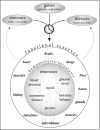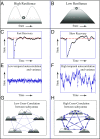Quantifying resilience of humans and other animals
- PMID: 30373844
- PMCID: PMC6255191
- DOI: 10.1073/pnas.1810630115
Quantifying resilience of humans and other animals
Abstract
All life requires the capacity to recover from challenges that are as inevitable as they are unpredictable. Understanding this resilience is essential for managing the health of humans and their livestock. It has long been difficult to quantify resilience directly, forcing practitioners to rely on indirect static indicators of health. However, measurements from wearable electronics and other sources now allow us to analyze the dynamics of physiology and behavior with unsurpassed resolution. The resulting flood of data coincides with the emergence of novel analytical tools for estimating resilience from the pattern of microrecoveries observed in natural time series. Such dynamic indicators of resilience may be used to monitor the risk of systemic failure across systems ranging from organs to entire organisms. These tools invite a fundamental rethinking of our approach to the adaptive management of health and resilience.
Keywords: aging; health; livestock; resilience; tipping points.
Copyright © 2018 the Author(s). Published by PNAS.
Conflict of interest statement
The authors declare no conflict of interest.
Figures



References
-
- Potts SG, et al. Global pollinator declines: Trends, impacts and drivers. Trends Ecol Evol. 2010;25:345–353. - PubMed
-
- Biesmeijer JC, et al. Parallel declines in pollinators and insect-pollinated plants in Britain and The Netherlands. Science. 2006;313:351–354. - PubMed
-
- Goulson D, Nicholls E, Botías C, Rotheray EL. Bee declines driven by combined stress from parasites, pesticides, and lack of flowers. Science. 2015;347:1255957. - PubMed
-
- Stokstad E. Pesticides under fire for risks to pollinators. Science. 2013;340:674–676. - PubMed
Publication types
MeSH terms
LinkOut - more resources
Full Text Sources

